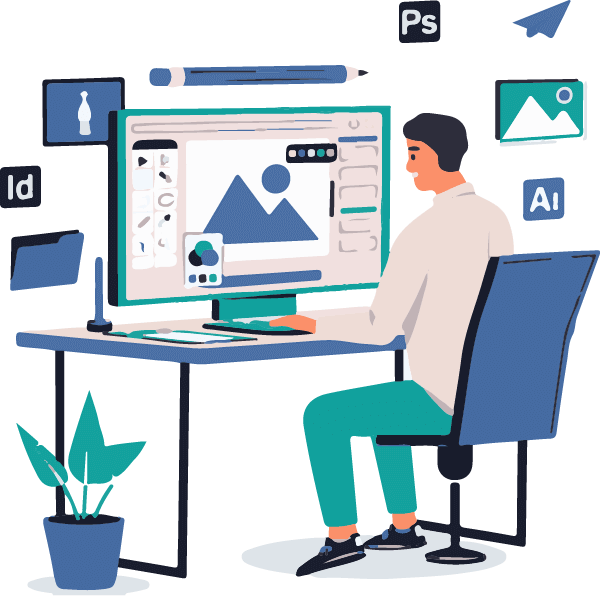Capture your readers’ imaginations with stunning illustrations. Izzard Ink offers expert book illustration services designed for writers who want to self-publish their work.


We have a pool of professional book illustrators for hire who can help turn your vision into a reality. Whether you need page, cover, or character illustrations, you can count on our book illustrators to deliver incredible output. Choose an illustrator whose style is right for your book.
We start our book illustration services by learning about you, your work, and your self-publishing goals. From there, we curate a list of illustrators we think are right for you. But the decision is yours; you get to handpick book illustrators for your team.


Children’s book illustrations bring stories to life, each style offering a unique visual flavor.
These styles, from the bold and dynamic to the subtle and serene, allow authors to tailor the visual experience to their narrative, captivating readers’ imaginations across every page.


No matter where you are on your publishing journey, we’re here to support and guide you toward success.
The cost of hiring a children’s book illustrator depends on several factors, but it’s a crucial investment in bringing your story to life! Here’s a breakdown to help you estimate costs:
Factors Influencing Cost
Cost Estimates
Additional Costs
Budgeting for Your Project
It’s crucial to account for all potential costs, including the illustrator’s fees and additional expenses such as editing, design, printing, and marketing. For a typical 32-page picture book, illustration costs alone can span from $1,600 to over $48,000, contingent on the aforementioned factors.
Conclusion
Investing in high-quality illustrations is a smart decision! Izzard Ink Publishing can help you navigate this process and connect you with talented illustrators who fit your budget and vision, making sure your children’s book is a success.
Finding the perfect illustrator for your children’s book is an important decision! Our experienced art director will carefully guide you through the process. Here’s how it works:
Our commitment to collaborative art direction ensures your children’s book is not only beautiful but a true reflection of your story.
Turning your children’s book vision into stunning illustrations requires clear communication with your illustrator and art director. Izzard Ink Publishing, we guide you through this process to ensure your book comes to life exactly as you imagine. Here’s a guide for this phase:
Understand Your Story
Start by deeply understanding the themes, characters, and settings of your story. Knowing what emotional tone and message you want to convey will guide your communication and choices for the illustrations.
Gather Inspirations
Collect images, artworks, or illustrations that closely match the style and mood you envision. These can serve as a visual reference point to share with your illustrator and art director.
Create a Mood Board
A mood board is an effective tool to compile your inspirations and ideas into one cohesive visual document. It can include colors, textures, character sketches, and anything that captures the essence of your book’s world.
Write a Brief
Develop a clear, concise brief detailing your vision. Include descriptions of key scenes, characters’ appearances, important themes, and any specific ideas for illustrations. Specify the emotional tone and any motifs or symbols that are significant to your story.
Communicate Your Expectations
Discuss your vision, mood board, and brief with your art director and illustrator. Open, ongoing communication is vital. Be open to their suggestions, as they bring expertise and creativity that can improve your initial ideas.
Review and Feedback
As sketches and drafts come in, provide constructive feedback. Be specific about what you like and what might need adjustment, referencing your initial vision and mood board to guide revisions.
Trust the Process
While it’s important to communicate your vision, trusting your illustrator and art director’s expertise is equally crucial. They’re skilled at bringing stories to life and can often suggest enhancements that align with your goals.
At Izzard Ink Publishing, we facilitate a collaborative environment where authors feel valuedand supported throughout the illustration process. By following these steps, you can effectively communicate your vision and ensure the final illustrations beautifully complement your children’s book, making it a captivating read for young audiences.
You’re involved in every step of the illustration process. Here’s how it typically works:
Ownership of the rights to illustrations in a book typically depends on the agreement between the author (or publisher) and the illustrator. These rights can be complex, basically determining who can use the illustrations and how. Here’s a breakdown to clarify things:
At Izzard Ink Publishing, we make sure these agreements are clear, fair, and customized for each project. We value both authors and illustrators, and a good contract helps everyone work together creatively. Understanding these rights is a big part of publishing, making sure everyone’s on the same page and the book has a strong legal foundation for success.
Artificial intelligence (AI) is getting really good at creative tasks, and illustration is no exception! AI can definitely illustrate a children’s book, offering some interesting advantages:
Considerations
We explore the potential of AI in children’s book illustration with a balanced approach, considering its benefits and limitations.
Whether we use AI or traditional methods, our main goal is to create illustrations that make your story come alive for readers, all while staying true to your vision. The world of book publishing is always changing with new technology, and AI offers exciting ways to bring stories to life visually!
The number of illustrations in your children’s book plays a big role in how well the story flows and keeps young readers engaged. At Izzard Ink Publishing, we can help you find the perfect balance between pictures and text to make your book shine!
Understanding Your Book’s Needs
Planning Your Illustrations
Guidelines for Different Book Types
The goal is to have just the right number of illustrations to make your children’s book fun and engaging to read without slowing down the story. We at Izzard Ink Publishing can work with you and your illustrator to decide where to place each illustration strategically, making sure they add something special to your story. Our goal is to create visually captivating books that young readers will love!


Writer's block?
Lacking confidence?
Seeking guidance?
Unlock your manuscript's potential with Izzard Ink's manuscript assessment. We'll identify specific areas for enhancement and offer targeted solutions. Connect with us, and together, we'll elevate your manuscript.
"*" indicates required fields


Writer's block?
Lacking confidence?
Seeking guidance?
Unlock your manuscript's potential with Izzard Ink's manuscript assessment. We'll identify specific areas for enhancement and offer targeted solutions. Connect with us, and together, we'll elevate your manuscript.